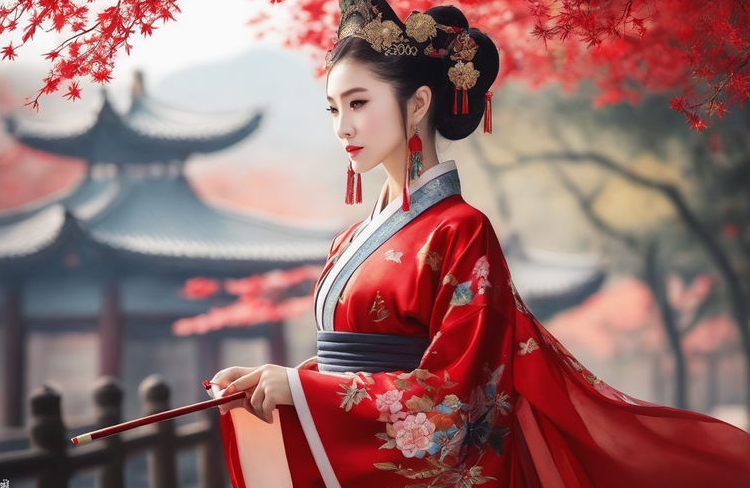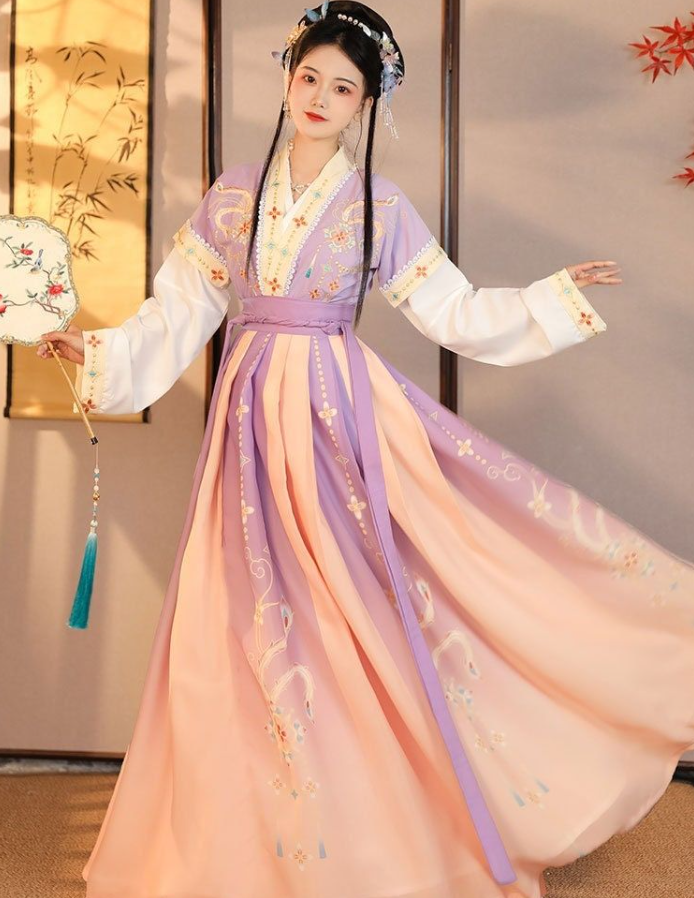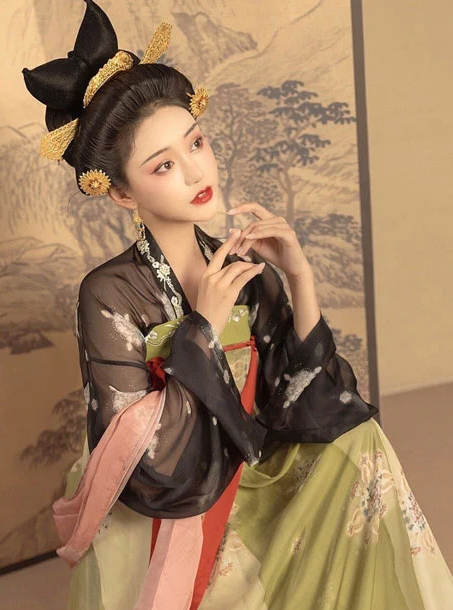Traditional hanfu parts include upper garments, lower garments, full-length robes, outerwear, and various accessories.
Upper Garments
Yi (衣)
The Yi represents the foundational upper garment in traditional Chinese attire. Often made of silk or linen, its design includes a crossed collar and ties or fastens to the right side. Historically, the design, color, and material of the Yi could indicate one’s social status or rank. Over centuries, various dynasties brought slight modifications to the Yi, but its essence has remained consistent. The Han Dynasty particularly popularized the use of the Yi in daily life.

Ao (袄)
The Ao serves as a type of jacket or overcoat, worn over the Yi. Generally characterized by its central opening, it offers both a formal and casual appeal. The Ao can vary in length, from waist-length to reaching down to the knees. Its usage is commonly seen during colder months. Notably, during the Ming Dynasty, the Ao was a staple garment among scholars and officials.
Banbi (半臂)
The Banbi is a distinctive half-sleeved, short jacket. Due to its cropped design, it is typically layered over another upper garment, offering an added flair to the outfit. Originating from the Tang Dynasty, the Banbi gained popularity among women for its stylish and functional design. It’s perfect for transitional weather, providing warmth without being overly restrictive.
Daxiushan (大袖衫)
The Daxiushan, or large-sleeved robe, stands out with its exaggerated, flowing sleeves. It’s a garment that exudes elegance and grandeur. Often reserved for special occasions, ceremonies, or by individuals of high stature, the Daxiushan is a testament to Chinese craftsmanship and design. The intricate patterns and embroidery on the Daxiushan often narrate tales from ancient Chinese mythology and folklore.
Lower Garments
Ku (裤)
The Ku represents traditional Chinese trousers or pants. Crafted primarily from materials like silk or cotton, they are designed for comfort and ease of movement. While traditionally loose-fitting and high-waisted, the Ku has seen variations across regions and dynasties. The Song Dynasty witnessed a rise in the popularity of Ku, especially among working-class individuals due to its practicality.
Chang (裳)
The Chang is synonymous with elegance in traditional Chinese fashion. Essentially a skirt, it is wrapped around the waist and can vary in length, from just below the knee to the ankles. Throughout history, the Chang has been adorned with intricate embroidery, patterns, and motifs, each narrating tales from ancient folklore or representing symbols of luck and prosperity. The Tang Dynasty is often lauded for its vibrant and diverse designs of the Chang, where it was a common attire among women of all classes.
Shanku (裳裤)
The Shanku is a unique piece of attire, merging the design of the Chang and Ku. It consists of trousers, often made of soft materials like silk, with an overlaying skirt panel either at the front or both front and back. This innovative design ensures the functionality of pants while retaining the elegance and flow of a skirt. Notably, during the Qing Dynasty, the Shanku became a popular choice for many, as it exemplified the perfect blend of style and utility.
Robes and Full-Length Garments
Shenyi (深衣)
The Shenyi is an emblematic one-piece robe in traditional Chinese fashion. Extending from the shoulders down to the ankles, this robe was often crafted from premium materials like silk, showcasing the finesse of Chinese textile craftsmanship. Its design incorporates both the upper and lower garments into a singular piece, offering simplicity and elegance. The Shenyi was a prevalent choice among scholars and officials during the Han Dynasty, symbolizing their status and intellectual stature.
Quju (曲裾)
Distinct for its curved hem, the Quju is a robe that combines both style and grace. This design detail, the curved hem, represents waves and is often seen as a symbol of fluidity and continuity. Embroideries on the Quju frequently depict scenes from nature, with motifs of flowers, birds, and landscapes, celebrating the profound connection between humans and nature evident in ancient Chinese philosophies like Taoism. Its popularity peaked during the Tang and Song Dynasties, marking its place in the annals of Chinese sartorial elegance.
Zhiju (直裾)
In contrast to the Quju, the Zhiju features a straight-hem design. This full-length robe embraces a minimalist appeal while maintaining its majesty. It was a common attire choice for various ceremonies and rituals due to its formal and dignified appearance. As with other traditional robes, the choice of colors, patterns, and materials in a Zhiju could indicate one’s social status or rank. The Ming Dynasty in particular favored the Zhiju, with many portraits from this era showcasing individuals adorned in this exquisite garment.
Outerwear and Overcoats
Pifeng (披风)
The Pifeng is a traditional Chinese cape or cloak, designed to provide additional warmth and style. Often made from luxurious materials like silk or brocade, the Pifeng is draped over the shoulders and extends down the back. Beyond its practicality, it also serves as a canvas for showcasing intricate embroidery and designs. Historically, wearing a Pifeng was a sign of elegance, especially during the cooler months. The Yuan Dynasty records several literary mentions of the Pifeng, emphasizing its popularity and significance.

Wusha (乌纱)
The Wusha is more than just a hat; it combines the essence of a hat with an attached veil. Primarily worn by officials, the Wusha signified rank and status. The veil portion served to shield the face, adding a layer of mystique and reverence. The design was also practical, protecting the wearer from dust and sun. As a symbolic headgear, its prominence can be traced back to the Tang Dynasty, where it was a distinctive mark of the imperial bureaucracy.
Bixi (蔽膝)
The Bixi is a decorative cloth that hangs from the waist, often extending to the knees or even the ankles. While it serves a functional purpose, protecting the wearer’s clothes from dirt or spills, the Bixi is also a statement piece. Adorned with elaborate patterns, symbols, and sometimes even calligraphy, the Bixi is reminiscent of ancient Chinese artistry. Emperors and high-ranking officials during the Qing Dynasty would often wear Bixi with motifs that signify power, longevity, and prosperity.
Accessories
Pei (帔)
The Pei is a decorative pendant, often worn around the neck or attached to garments. Crafted with exquisite artistry, these pendants were typically made of jade, precious stones, or metals and often symbolized good fortune, health, or protection. The significance of the Pei can be traced back to ancient Chinese dynastic rituals, where they were used both as adornments and talismans.
Dai (带)
The Dai encompasses a range of belts and sashes, fundamental to the traditional Chinese attire. Beyond their practical use of holding garments in place, the Dai became a canvas for showcasing craftsmanship. Elaborate embroidery, intricate buckle designs, and the use of premium materials made them a fashion statement. Historically, the Hanfu belt (a form of Dai) was a crucial part of one’s ensemble, symbolizing one’s social standing and personal style.
Jin (巾)
The Jin represents traditional Chinese headwear or turbans. Made primarily of cloth, it served multiple purposes – from protecting the head from the elements to symbolizing one’s status or profession. Over the centuries, variations of the Jin emerged, with different regions and dynasties lending their unique styles. Scholars, for instance, had specific ways of tying the Jin, distinguishing them from other societal groups. The Song Dynasty saw a rise in the diversity of Jin designs, reflecting the era’s cultural richness.

Xie (鞋)
Xie pertains to traditional Chinese shoes. Made from materials ranging from cotton cloth to embroidered silk, these shoes are recognized for their elevated soles and intricate designs. Some notable types include the “thousand-layer” shoes and the “horse-hoof” shoes, each with its own historical and cultural significance. Footwear, like the lotus shoes associated with the controversial practice of foot binding, reflects the evolving (and sometimes painful) beauty standards and cultural practices of Chinese history.\